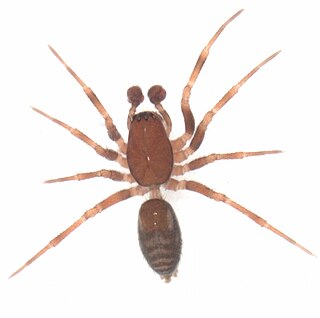
Linyphiidae is a family of very small spiders comprising 4667 described species in 618 genera worldwide. This makes Linyphiidae the second largest family of spiders after the Salticidae. The family is poorly known; new genera and species are still being discovered throughout the world. The newest such genus is Yuelushannus from China, formally described in May 2020. Because of the difficulty in identifying such tiny spiders, there are regular changes in taxonomy as species are combined or divided.

Walckenaeria is a genus of dwarf spiders that was first described by John Blackwall in 1833. It is a senior synonym of Paragonatium, as well as Wideria, Cornicularia, Prosopotheca, Tigellinus, and Trachynella.
Wabasso is a genus of sheet weavers that was first described by Alfred Frank Millidge in 1984.

Agyneta is a genus of dwarf spiders that was first described by J. E. Hull in 1911.
Scotinotylus is a genus of sheet weavers that was first described by Eugène Louis Simon in 1884.
Labicymbium is a genus of South American dwarf spiders that was first described by Alfred Frank Millidge in 1991.
Laminacauda is a genus of dwarf spiders that was first described by Alfred Frank Millidge in 1985.
Spirembolus is a genus of North American sheet weavers that was first described by Ralph Vary Chamberlin in 1920.
Annapolis is a monotypic genus of North American dwarf spiders containing the single species, Annapolis mossi. It was first described by Alfred Frank Millidge in 1984, and has only been found in United States.
Atypena is a genus of Asian dwarf spiders that was first described by Eugène Louis Simon in 1894.
Nesioneta is a genus of dwarf spiders that was first described by J. A. Beatty, J. W. Berry & Alfred Frank Millidge in 1991.
Diploplecta is a genus of South Pacific dwarf spiders that was first described by Alfred Frank Millidge in 1988.
Disembolus is a genus of North American dwarf spiders that was first described by Ralph Vary Chamberlin & Vaine Wilton Ivie in 1933.

Dunedinia is a genus of South Pacific dwarf spiders that was first described by Alfred Frank Millidge in 1988.
Exechopsis is a genus of South American dwarf spiders that was first described by Alfred Frank Millidge in 1991. As of May 2019 it contains only three species: E. conspicua, E. eberhardi, and E. versicolor.
Masikia is a genus of dwarf spiders that was first described by Alfred Frank Millidge in 1984.
Palaeohyphantes is a monotypic genus of Australian dwarf spiders containing the single species, Palaeohyphantes simplicipalpis. It was first described by Alfred Frank Millidge in 1984, and has only been found in Australia.

Saaristoa is a genus of sheet weavers that was first described by Alfred Frank Millidge in 1978.
Subbekasha is a monotypic genus of North American sheet weavers containing the single species, Subbekasha flabellifera. It was first described by Alfred Frank Millidge in 1984, and has only been found in Canada.
Tachygyna is a genus of North American sheet weavers that was first described by Ralph Vary Chamberlin & Vaine Wilton Ivie in 1939.




